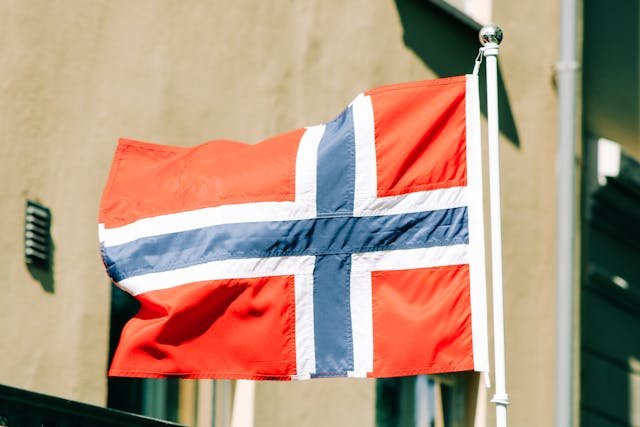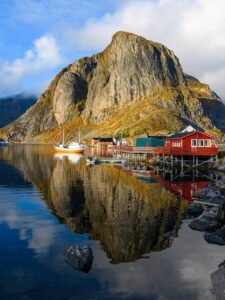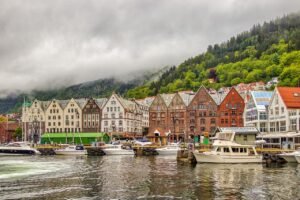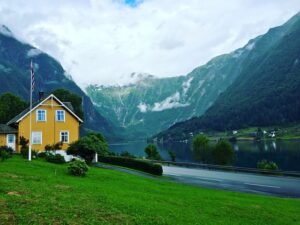

17. Mai: What Do the Words in Norway’s National Anthem Mean?
Every year, on the 17th of May, the streets of Norway are filled with festive parades, flags, and joyful celebrations. This day is not just any national holiday—it’s Norway’s Constitution Day, commemorating the signing of the constitution at Eidsvoll in 1814. One of the key traditions on this day is the singing of the national anthem, “Ja, vi elsker dette landet” (“Yes, we love this land”), written by Bjørnstjerne Bjørnson with music composed by Rikard Nordraak. For many Norwegians, singing this anthem is a deeply emotional and patriotic experience, yet the historical and poetic language can sometimes be difficult to fully grasp, especially for non-native speakers or those unfamiliar with older Norwegian dialects.
In this article, we’ll dive deep into the meaning of the words in Norway’s national anthem, exploring its historical context, literary style, and the significance of each verse.
If you’d like to immerse yourself more in the Norwegian language and culture, consider signing up for Norwegian classes at NLS Norwegian Language School in Oslo. Here is the link to register for group classes.
Table of Contents
ToggleHistorical Context of “Ja, vi elsker”
“Ja, vi elsker dette landet” was first performed publicly in 1864 to celebrate the 50th anniversary of the Norwegian Constitution. During this period, Norway was in a union with Sweden, and the anthem reflects a growing sense of national identity and the desire for self-determination. Bjørnson, a leading figure in the cultural and political life of Norway, wrote the anthem to inspire pride and hope among Norwegians.
The anthem’s tone is both reverent and reflective, acknowledging the hardships of the past while looking towards a hopeful future. It tells the story of a nation that has endured adversity but has remained strong through its love for its people and its land.
Verse 1: Love for the Land
Ja, vi elsker dette landet, som det stiger frem, furet, værbitt over vannet, med de tusen hjem, elsker, elsker det og tenker, på vår far og mor, og den saganatt som senker drømmer på vår jord.
Translation: Yes, we love this country, as it rises forth, rugged, weather-beaten over the water, with the thousand homes, we love, we love it and think, of our father and mother, and the saga-night that sends dreams to our earth.
The opening verse sets the stage with a powerful declaration of love for Norway. The phrase “som det stiger frem” (“as it rises forth”) paints a vivid picture of the Norwegian landscape, emerging proudly from the sea, symbolizing the country’s natural beauty and strength.
“Furet, værbitt” refers to the rugged and weathered landscape of Norway, shaped by centuries of harsh weather conditions, especially along the coastline. This imagery connects the land itself to the resilience of the Norwegian people, who have endured the challenging conditions of their environment.
The mention of “vår far og mor” (“our father and mother”) represents the generations that have come before, those who have built the country and preserved its culture. The line “den saganatt som senker drømmer på vår jord” (“the saga-night that sends dreams to our earth”) refers to the rich history of the Norse sagas, which are integral to the national identity. The sagas are not just stories but a symbol of a shared cultural heritage that continues to inspire dreams for the future.
Verse 2: The Struggles and Strength of Norway
Dette landet Harald berget med sin kjemperad, dette landet Håkon verget, medens Øyvind kvad; Olav på det landet malte korset med sitt blod, fra dets høye Sverre talte Roma midt imot.
Translation: This land Harald saved with his warrior-band, this land Håkon defended while Øyvind sang; Olav painted the cross on this land with his blood, from its heights Sverre spoke against Rome.
The second verse turns to Norway’s past, celebrating the legendary kings who shaped the nation’s history. Harald, often referred to as Harald Fairhair, is credited with uniting Norway into one kingdom. His mention in the anthem is a tribute to the founding of the nation.
Håkon, likely referring to Håkon the Good, played a significant role in defending Norway from external threats. His protection of the country, coupled with the poet Øyvind’s songs, emphasizes both the military and cultural forces that helped preserve Norway’s independence and identity.
Olav, known as Saint Olav, is a central figure in Norwegian history, credited with Christianizing the country. The reference to him painting the cross with his blood symbolizes the sacrifices made in the name of faith and country. Finally, Sverre, a king who challenged the authority of the Catholic Church in Rome, represents Norway’s long-standing spirit of independence and resistance to foreign control.
Verse 3: Overcoming Hardship
Bønder sine økser brynte, hvor en hær drog frem; Tordenskiold langs kysten lynte, så den lystes hjem. Kvinner selv stod opp og strede, som de vare menn: andre kunne bare grede, men det kom igjen!
Translation: Farmers sharpened their axes wherever an army advanced; Tordenskiold flashed along the coast, so it lit their way home. Women themselves stood up and fought, as if they were men: others could only weep, but it came again!
This verse celebrates the contributions of ordinary people to the defense and preservation of Norway. The reference to farmers sharpening their axes speaks to the importance of the rural population in resisting invaders. This highlights the collective effort of all Norwegians, not just the military, in safeguarding the nation.
Tordenskiold, a famous Norwegian naval hero, represents the power of the sea in Norway’s defense. His bold and daring exploits along the coast are remembered as key moments in the country’s struggle for survival.
The mention of women standing up to fight “as if they were men” honors the role of Norwegian women in times of conflict. While many fought directly, others endured suffering and loss, yet the line “men det kom igjen!” (“but it came again!”) suggests resilience and the promise of renewal. Despite hardships, the spirit of the people endures.
Verse 4: Freedom and Unity
Visstnok var vi ikke mange; men vi strakk dog til, da vi prøvdes noen gange, og det stod på spill; ti vi heller landet brente enn det kom til fall; husker bare, hva som hendte ned på Fredrikshald!
Translation: Certainly, we were not many; but we were enough, when we were tested several times, and it was at stake; for we would rather burn the land than see it fall; just remember what happened down at Fredrikshald!
This verse reflects Norway’s small population, yet emphasizes that even though the nation was small in number, the strength and determination of its people were enough to overcome challenges. The phrase “vi strakk dog til” (“we were enough”) speaks to the idea that when faced with adversity, the Norwegian people rose to the occasion.
The line “vi heller landet brente” (“we would rather burn the land”) refers to a common military tactic used in times of invasion—scorched earth—where Norwegians would destroy their own land and resources rather than let it fall into enemy hands. This is a powerful symbol of their unwavering commitment to national independence.
The mention of Fredrikshald refers to a famous battle during the Great Northern War when Norwegians successfully defended the fortress town of Halden from a Swedish invasion. This victory became a symbol of national pride and resilience.
Verse 5: Looking to the Future
Høyt vårt håp er evig hevet; det har huldt oss ny, og som fedres kamp har skrevet, vil vår fremtid bli. Vi skal ikke selges, kjøpes; ikke temmes ned; å, vi vil den frihet dyrke, som vi vant oss ved.
Translation: High our hope is forever lifted; it has kept us young, and as our fathers’ struggle has written, so will our future be. We will not be sold, bought; not tamed; oh, we will cultivate the freedom that we won for ourselves.
In the fifth verse, the focus shifts to the future. The anthem expresses hope and optimism, stating that the spirit of freedom and independence that has guided Norway through the centuries will continue to shape its destiny. The phrase “det har huldt oss ny” (“it has kept us young”) suggests that hope and national pride are rejuvenating forces for the country.
The final lines of the verse, “Vi skal ikke selges, kjøpes; ikke temmes ned” (“We will not be sold, bought; not tamed”), are a powerful declaration of Norway’s independence and self-reliance. The anthem reinforces that the country’s freedom is not negotiable and that it will be preserved at all costs.
Verse 6: The Eternal Spirit of Norway
Elsker, elsker det og tenker, på vår far og mor og den saganatt som senker drømmer på vår jord.
Translation: We love, we love it and think, of our father and mother, and the saga-night that sends dreams to our earth.
The final verse is a repetition of the opening lines, emphasizing once again the deep love and respect for the land, the ancestors, and the rich cultural heritage. The reference to the saganatt (saga-night) once again connects the present to the past, reminding Norwegians that their identity is built on the stories and struggles of their forebears.
This cyclical structure—beginning and ending with love for the country and its history—reinforces the idea that Norway’s national identity is timeless, with the past, present, and future all intertwined.
The Anthem’s Lasting Legacy
“Ja, vi elsker dette landet” continues to resonate with Norwegians today, not just as a song of national pride but as a reminder of the country’s journey towards independence, unity, and peace. The anthem speaks to the love of the land, the importance of history, and the strength of the people.
For those eager to deepen their understanding of Norwegian culture and language, enrolling in Norwegian classes at NLS Norwegian Language School can be an excellent way to explore these themes further. Register for group classes here and embrace the rich linguistic and cultural tapestry of Norway.
Whether you’re singing along with the crowd on 17. mai or exploring Norway’s sagas and history, understanding the words of the national anthem can bring you closer to the heart of this proud nation.
If you want to learn Norwegian, you can register for classes here. We look forward to hearing from you and helping you become fluent in Norwegian.





